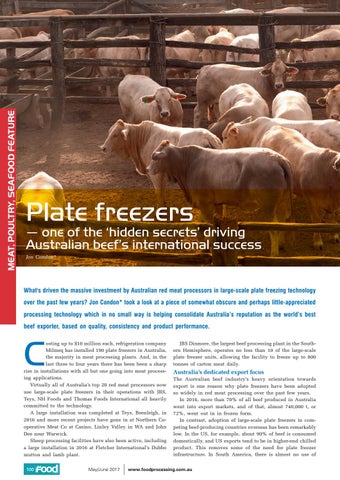MEAT, POULTRY, SEAFOOD FEATURE
Plate freezers
— one of the ‘hidden secrets’ driving Australian beef’s international success Jon Condon*
What's driven the massive investment by Australian red meat processors in large-scale plate freezing technology over the past few years? Jon Condon* took a look at a piece of somewhat obscure and perhaps little-appreciated processing technology which in no small way is helping consolidate Australia’s reputation as the world’s best beef exporter, based on quality, consistency and product performance.
C
osting up to $10 million each, refrigeration company Milmeq has installed 190 plate freezers in Australia, the majority in meat processing plants. And, in the last three to four years there has been been a sharp rise in installations with all but one going into meat processing applications. Virtually all of Australia’s top 20 red meat processors now use large-scale plate freezers in their operations with JBS, Teys, NH Foods and Thomas Foods International all heavily committed to the technology. A large installation was completed at Teys, Beenleigh, in 2016 and more recent projects have gone in at Northern Cooperative Meat Co at Casino, Linley Valley in WA and John Dee near Warwick. Sheep processing facilities have also been active, including a large installation in 2016 at Fletcher International’s Dubbo mutton and lamb plant. 100
May/June 2017
JBS Dinmore, the largest beef processing plant in the Southern Hemisphere, operates no less than 10 of the large-scale plate freezer units, allowing the facility to freeze up to 800 tonnes of carton meat daily.
Australia’s dedicated export focus The Australian beef industry’s heavy orientation towards export is one reason why plate freezers have been adopted so widely in red meat processing over the past few years. In 2016, more than 70% of all beef produced in Australia went into export markets, and of that, almost 740,000 t, or 72%, went out in in frozen form. In contrast, adoption of large-scale plate freezers in competing beef-producing countries overseas has been remarkably low. In the US, for example, about 90% of beef is consumed domestically, and US exports tend to be in higher-end chilled product. This removes some of the need for plate freezer infrastructure. In South America, there is almost no use of
www.foodprocessing.com.au
